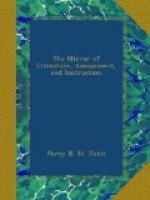Home we came, and there we found two letters: one from Mr. Camden, sent per coach, to say that he found they must go abroad immediately, and that they could not therefore think of coming into Berkshire for a year or more; one from the lawyer, left in charge of Hatherden, to say, that we could not have the place, as the Norrises were returning to their old house forthwith. And my Castle is knocked down, blown up—which is the right word for the demolishing such airy edifices? And Hatherden is as far-off, and the hill as steep, and the common as dreary as ever.
We have already quoted the most striking of the poetical pieces, at page 283. Allan Cunningham has some spirited lines, My Native Vale; and the Ettrick Shepherd, a touching Lay of the Martyrs. Archdeacon Wrangham, one of the most elegant and classical scholars of the day, has translated twenty-three beautiful verses on the Spider, from Pignotti, besides a few other little garnishing pieces. The Brothers, a Sketch, by the Hon. Mrs. Norton, is full of sweet simplicity; and some Stanzas, which follow, by Mr. Crofton Croker, are gems of affection. Thoughts on Flowers, by H.G. Bell, breathe the same sweet and touching spirit; and the Banks of the Dove, written by M.T. Sadler, Esq. on leaving his “native village in early youth,” are not only interesting as gems of talent which has since ripened into literary distinction in honourable public service, but will delight every admirer of genuine feeling.
The Engravings are nearly all of first-rate excellence. The frontispiece, the Minstrel of Chamouni, after Pickersgill, by J.H. Robinson, in effect, spirit, and finish, cannot be surpassed. But how shall we describe the Crucifixion, engraved by Le Keux, from a drawing by Martin: how can we speak of the light shedding over the Holy City and “Calvary’s wild hill,” the crucified MESSIAH, the living stream, and the thousands and tens of thousands that cluster on this “earthly throne”—the magnificent architectural masses—the vivid light streaming in the distance; and the warlike turmoil of helmet heads, spears and floating banners that aid the shout of blood in the foreground: this must suffice. The First Interview between the Spaniards and Peruvians, after Briggs, by Greatbach, is a triumph of art; Wilkie’s Dorty Bairn is excellent; the Fisherman’s Children, after Collins, by C. Rolls, is exquisitely delicate; and the Gleaner, by Finden, after Holmes, has a lovely set of features, which art and fashion may court in vain. But we have outrun our tether, and must halt here.
* * * * *
The Literary Souvenir.




